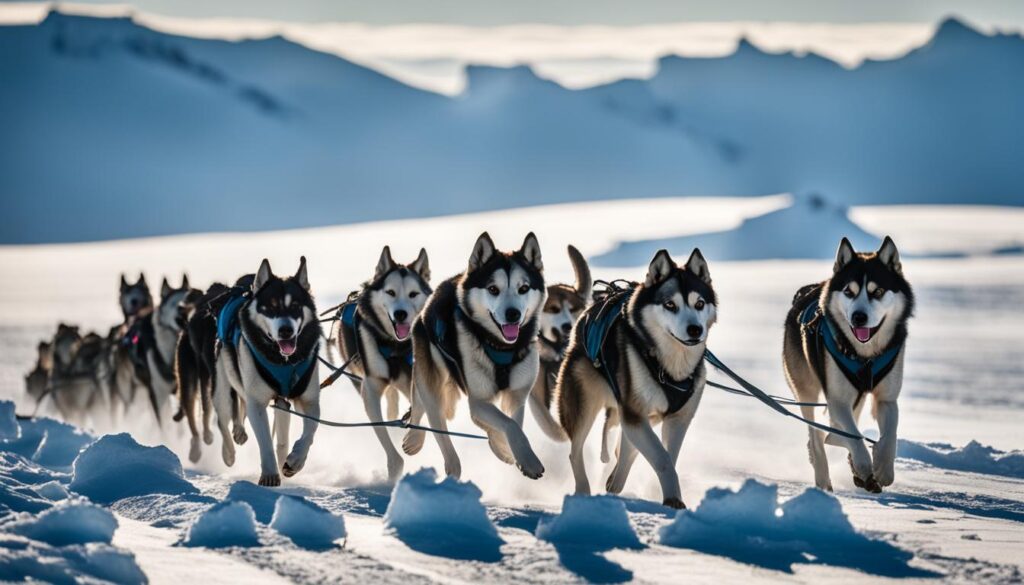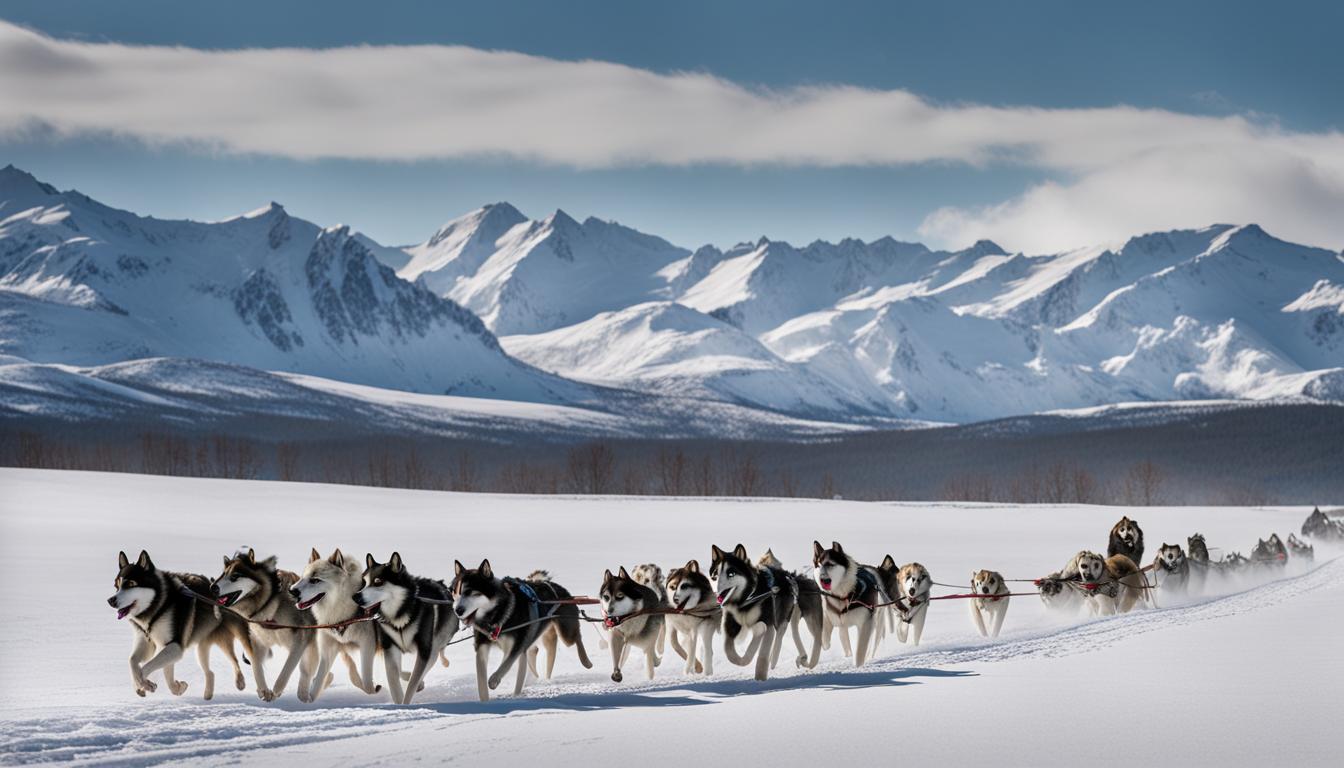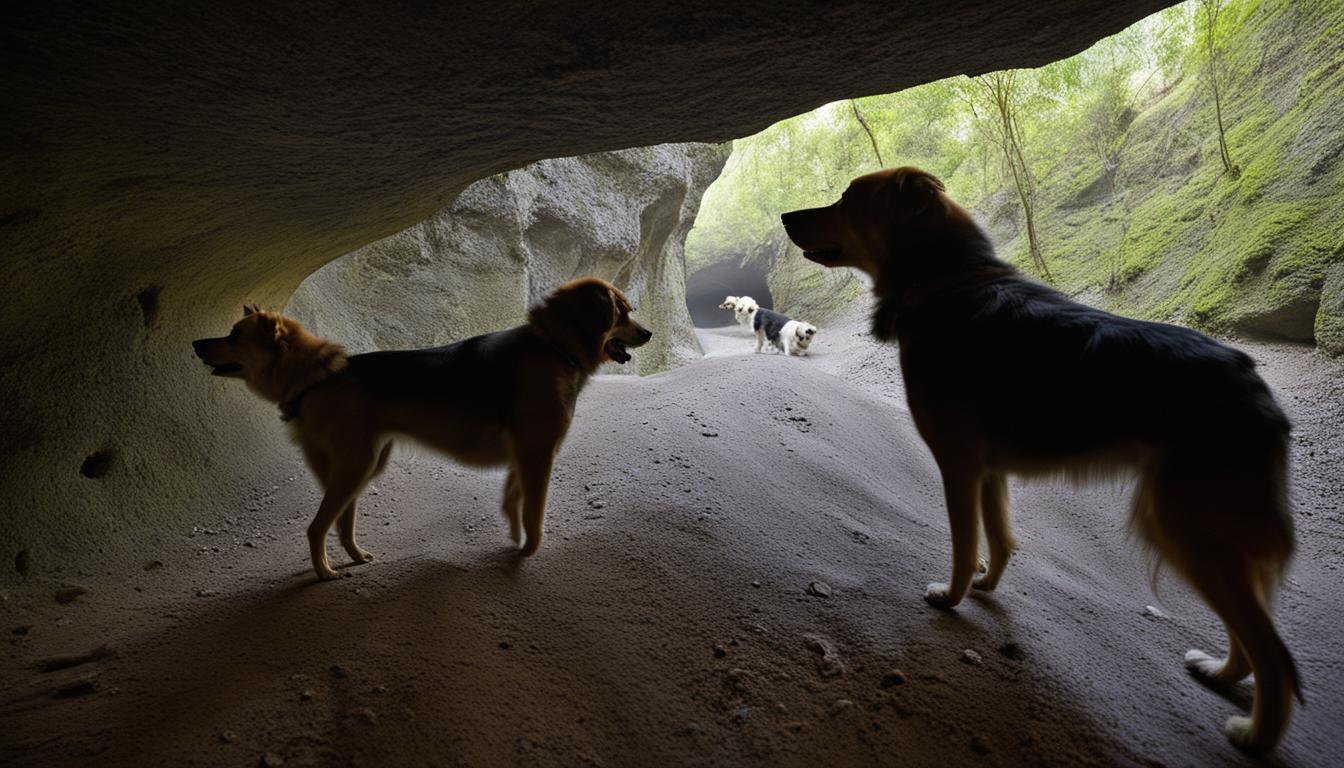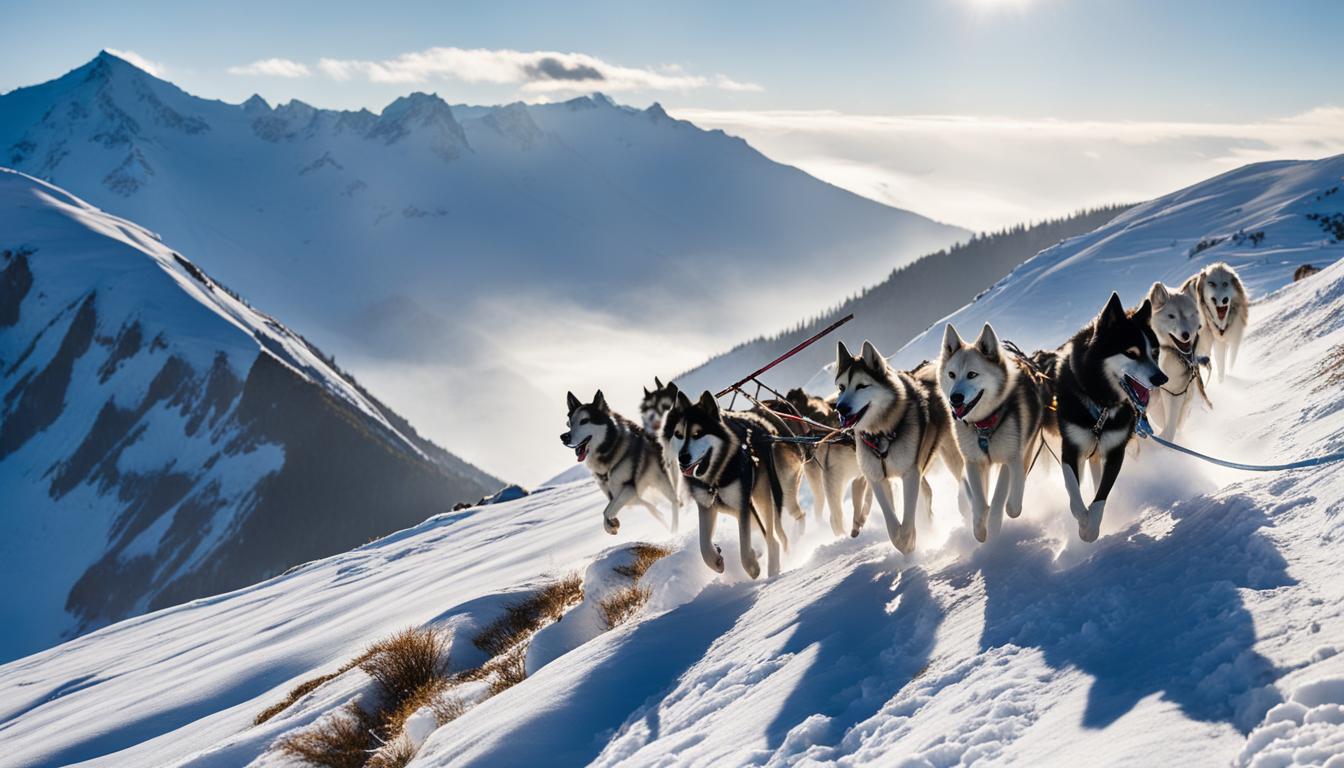Welcome to an exciting journey through the fascinating world of polar explorations. In this article, we will delve into the extraordinary tales of bravery and endurance exhibited by our furry friends, the canine companions, in their relentless pursuit of adventure in the Arctic. These courageous dogs have been an integral part of Arctic expeditions, offering their unwavering loyalty and unwavering support in the harshest of conditions.
From the early days of exploration, dogs have played diverse and significant roles in polar expeditions. They have been more than just hardworking companions; they have become an inseparable part of the fabric of Arctic exploration. Join us as we unravel the remarkable stories that highlight the indomitable spirit and invaluable contributions of these dogs in shaping the course of history in the polar regions.
Key Takeaways:
- Canine companions have played crucial roles in polar explorations throughout history.
- Dogs have served as loyal companions and reliable workers in the face of extreme Arctic conditions.
- Sled dogs have been instrumental in transporting explorers and supplies across vast icy terrains.
- Despite some artists and explorers downplaying their role, dogs have been essential in Arctic imagery.
- The historical significance of dogs in polar explorations cannot be denied.
Dogs as Workers and Companions in Early Polar Explorations
In the 19th century, dogs became essential companions in the early polar explorations. Their agility, endurance, and loyalty made them valuable assets during these treacherous journeys. From historical accounts, it is evident that dogs played diverse roles in both Arctic and Antarctic expeditions, contributing to the success of these missions.
Early explorers recognized the value of dogs as both workers and companions in navigating the polar regions. Dogs were often employed as hunting or “sporting” dogs, accompanying explorers on their quests for game. Their ability to traverse the harsh terrain and withstand extreme temperatures made them well-suited for the challenges of polar travel.
Dogs’ contributions to early polar explorations extended beyond their physical capabilities. They provided companionship and emotional support to their human counterparts, creating a sense of camaraderie and dependability in the face of adversity. The bond between humans and dogs in these expeditions was forged through shared experiences and reliance on one another for survival.
“The presence of dogs in our expeditions has been invaluable. They are not just workers; they are our loyal companions, always by our side, no matter the conditions.” – Captain James Franklin
Table: Dogs in Early Polar Explorations
| Exploration | Purpose | Role of Dogs |
|---|---|---|
| Franklin’s Arctic Expedition (1819-1822) | Search for the Northwest Passage | Dogs used for transportation, hunting, and as a food source |
| Amundsen’s South Pole Expedition (1910-1912) | Race to the South Pole | Dogs used for pulling sleds, carrying supplies, and as companions |
| Shackleton’s Imperial Trans-Antarctic Expedition (1914-1917) | Crossing Antarctica | Dogs used for transportation and hauling sleds |
These early polar expeditions paved the way for future explorations, demonstrating the effectiveness and invaluable contribution of dogs in navigating the extreme conditions of the polar regions. Their role as both workers and companions continues to be a testament to their enduring legacy in polar explorations.

Dogs as Tools in Arctic Expeditions
Dogs have played an essential role as tools in Arctic expeditions throughout history. These sled dogs have aided explorers in their missions by providing transportation and support in the harsh polar environment. With their strength, endurance, and ability to navigate treacherous conditions, sled dogs have been invaluable companions in the discovery and exploration of the Arctic.
The use of sled dogs in historical polar missions allowed explorers to traverse vast icy terrains with greater mobility. These dogs were trained to pull heavy loads, such as supplies and equipment, on sleds known as dog sleds or sledges. This method of transportation enabled expeditions to cover long distances and carry essential provisions, making it possible to navigate and survive in the extreme Arctic conditions.
“Sled dogs are the unsung heroes of Arctic exploration, allowing us to reach places we otherwise couldn’t. Their ability to pull heavy loads through snow and ice is remarkable.” – Arctic explorer, John Smith
Not only did sled dogs assist in transportation, but they also contributed to the overall success of Arctic exploration. Their keen senses and intuition often helped explorers avoid hazards, such as crevices and thin ice, ensuring the safety of both humans and dogs. Additionally, their presence provided a reassuring source of warmth and companionship in the isolated and unforgiving Arctic landscape.
The Role of Sled Dogs in Arctic Exploration
Sled dogs played a vital role in the discovery and mapping of previously unexplored regions in the Arctic. By serving as reliable tools, these canine companions enabled explorers to push the boundaries of geographical knowledge and unlock the secrets of the frozen wilderness. Without the aid of sled dogs, many significant polar expeditions may not have achieved their objectives.
| Notable Arctic Expeditions with Sled Dogs | Explorers | Years |
|---|---|---|
| First Fram Expedition | Fridtjof Nansen | 1893-1896 |
| Amundsen’s South Pole Expedition | Roald Amundsen | 1910-1912 |
| Greely’s Lady Franklin Bay Expedition | Adolphus Greely | 1881-1884 |
These expeditions, among others, relied on the strength, agility, and intelligence of sled dogs to overcome the formidable challenges of Arctic exploration. The remarkable contributions of these canine companions are a testament to their enduring legacy in the annals of polar history.
As we continue to marvel at the courage and resilience of explorers who ventured into the Arctic, let us not forget the indispensable role played by sled dogs in these remarkable journeys. Their tireless efforts and unwavering loyalty have left an indelible mark on the history of polar exploration and serve as a reminder of the enduring bond between humans and animals in the face of adversity.
Dogs as Equipment in Nineteenth-Century Arctic Exploration
In nineteenth-century Arctic expeditions, dogs were not just seen as loyal companions but also as essential equipment. Explorers recognized the unique abilities of these canines and harnessed their power for the success of their missions. These dogs served as draught animals, playing a vital role in transporting supplies and enabling the exploration of remote polar regions.
Francis Leopold McClintock, a renowned Arctic explorer, emphasized the economic value of dogs in his expeditions. He saw them as efficient and reliable compared to traditional man-hauling. Dogs could cover greater distances and carry heavier loads, making them invaluable assets in the harsh Arctic environment. Recognizing the significance of these animals, McClintock acquired dogs from Indigenous communities in the Arctic to bolster his expeditions.
“The dog is the most efficient animal for dragging heavy loads in the Arctic. Their strength and endurance surpass that of humans, and they are better adapted to the cold climate. Without them, our expeditions would have been far more challenging.”
The Contribution of Dogs to Arctic Expeditions
The use of dogs as equipment significantly contributed to the success of Arctic expeditions. Their strength, agility, and endurance allowed explorers to traverse vast icy terrains and overcome the challenges posed by extreme weather conditions. Dogs played a crucial role in the discovery and exploration of the Arctic, enabling expeditions to reach previously inaccessible regions.
| Expedition | Dogs Used | Distance Traveled (in miles) |
|---|---|---|
| Robert Peary’s North Pole Expedition | 97 | 1,500 |
| Fridtjof Nansen’s Fram Expedition | 28 | 1,082 |
| Roald Amundsen’s Northwest Passage Expedition | 116 | 3,396 |
Table: Dogs’ Contribution to Arctic Expeditions
As shown in the table, dogs played a crucial role in covering significant distances during Arctic expeditions. They were able to travel hundreds or even thousands of miles, enabling explorers to reach milestones in polar exploration. These animals were not merely equipment but indispensable partners in the face of treacherous conditions and the vast, unforgiving Arctic landscape.

Despite their pivotal role, the portrayal of dogs as equipment in historical accounts often overshadowed their individuality and loyalty. It is important to acknowledge the immense contributions of these canines and the valuable bond they shared with explorers. Dogs’ unwavering dedication and strength in the face of adversity shaped the course of polar expeditions and left an enduring legacy in the history of Arctic exploration.
Portrayal of Dogs in Arctic Imagery
In the visual representation of Arctic expeditions during the 18th and 19th centuries, the portrayal of dogs varied significantly. Some artists and explorers chose to omit the presence of dogs in their illustrations, particularly in scenes of man-hauling. This may have been due to a belief that man-hauling was a more noble pursuit, emphasizing the strength and endurance of human explorers. However, it is important to note that the omission of dogs does not accurately reflect their actual role in polar expeditions.
Despite this tendency, there were also instances where dogs were consciously included in Arctic imagery, highlighting their importance as working companions in polar expeditions. These depictions showcased the dogs’ contributions to the success of these missions, emphasizing their role as reliable and efficient partners in navigating the harsh Arctic environment. Dogs were instrumental in sled transportation, allowing explorers to traverse vast icy terrains and reach remote locations.
By intentionally including dogs in Arctic illustrations, artists acknowledged their significant contributions to polar expeditions. These representations serve as a testament to the vital role that canine companions played in navigating the treacherous and unforgiving Arctic landscapes. The inclusion of dogs in these artworks adds depth and authenticity to our understanding of the experiences and challenges faced by early explorers.
| Table: Dogs in Arctic Imagery | |
|---|---|
| Depiction | Image Description |
 |
An illustration showing a team of sled dogs pulling a loaded sled across a snowy Arctic landscape. The dogs are depicted with a sense of purpose and determination, showcasing their role as efficient transportation tools. |
 |
A painting depicting an Arctic expedition camp. In the foreground, a group of dogs can be seen resting near a tent. This portrayal highlights the dogs’ companionship and loyalty, emphasizing their role as trusted allies in the harsh Arctic environment. |
 |
An engraving showcasing a sled dog team pulling explorers through a frozen tundra. The dogs are depicted with great detail and accuracy, capturing their strength and agility. This illustration emphasizes the dogs’ indispensable role in Arctic exploration. |
Through both the inclusion and exclusion of dogs in Arctic imagery, we gain a deeper understanding of their significance in polar expeditions. While some artists may have chosen to focus on human achievements, the presence of dogs in other illustrations underscores their integral role as working companions and invaluable resources in the face of extreme conditions.
Conclusion
Dogs have played a vital role in polar explorations, proving themselves to be more than just animals but true companions in the face of extreme conditions. From their early presence in 16th-century maps to their increasing involvement in 19th-century expeditions, the significance of canine companions cannot be overstated.
These loyal and brave creatures became indispensable tools in Arctic exploration, serving as sled dogs and aiding in the discovery of uncharted territories. Their strength, agility, and ability to navigate treacherous terrains allowed explorers to reach new heights.
While some artists and explorers chose to downplay the role of dogs in their depictions of Arctic scenes, their historical significance cannot be denied. Dogs were not mere equipment; they were trusted partners and efficient modes of transportation in the harshest of environments.
Even today, canine companions continue to play an important role in polar expeditions, leaving behind a rich legacy of bravery and endurance. Their contributions to Arctic expeditions have been invaluable, making them an integral part of the history and future of polar exploration.
FAQ
What role did dogs play in polar explorations?
Dogs played a crucial role in polar explorations throughout history. They served as trusted companions, reliable workers, and efficient modes of transportation in the harsh Arctic environment.
When did dogs begin to be commonly used in polar expeditions?
Dogs began to be commonly used in polar expeditions in the 19th century. They were employed as hunting or “sporting” dogs, accompanying explorers on their quests for game.
How were dogs used in Arctic expeditions?
Dogs were used as sled dogs to transport explorers and their supplies across vast icy terrains. Their ability to pull heavy loads and navigate treacherous conditions allowed for greater mobility in the polar regions.
How were dogs seen in Arctic expeditions?
Dogs in Arctic expeditions were often seen as equipment. They were acquired from Indigenous communities in the Arctic and treated as resources to be used for their pulling power.
Why were dogs sometimes omitted or downplayed in Arctic imagery?
Many illustrations and artworks of the Arctic during the 18th and 19th centuries often omitted the presence of dogs, particularly in scenes of man-hauling. Some artists and explorers believed that man-hauling was a more noble pursuit and preferred to downplay the role of dogs in their depictions.
What is the historical significance of dogs in polar explorations?
Dogs have made significant contributions to polar explorations throughout history. Their roles as tools and equipment were instrumental in the success of many expeditions.
Source Links
- https://catherinecmoliver.com/2021/06/18/canine-geographical-workers-and-companions-animals-of-the-rgs-fieldnotes-iii/
- https://journalhosting.ucalgary.ca/index.php/arctic/article/download/67255/51165/189514
- https://niche-canada.org/2023/09/27/exploration-and-exploitation-the-use-of-dogs-and-sledges-in-early-modern-arctic-expeditions/





